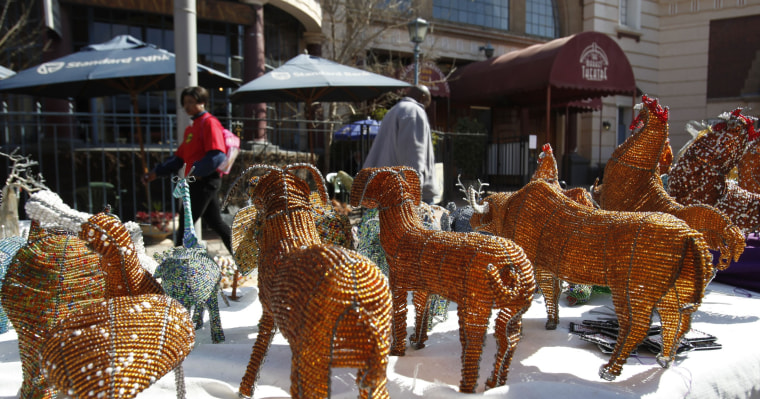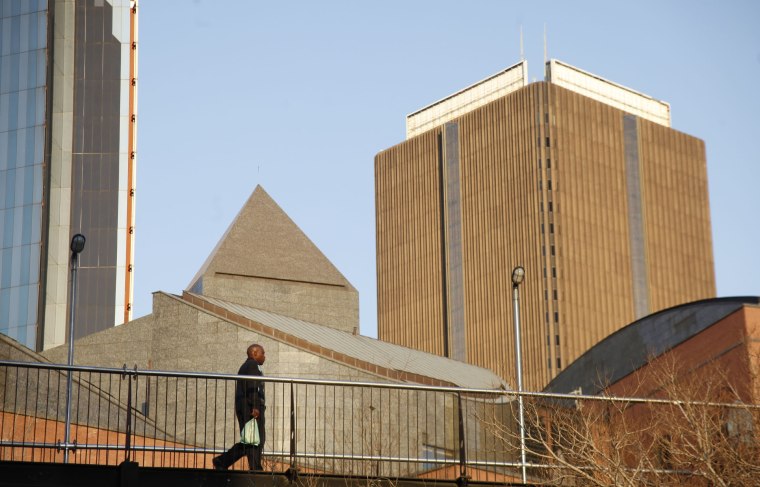It's gritty, it's hip and it's downtown in one of the most dangerous cities in the world.
Johannesburg's Newtown cultural precinct is at the heart of life in this city, and a visit reveals just why this is one of Africa's great metropolitan centers.
Newtown is home to a theater famed for its role in the fight against apartheid, one of the continent's premier jazz clubs, and a restaurant offering up a taste of South Africa in all its flavors.
Its roads are named after some of the country's best writers, painters and voices such as the late African songbird Miriam Makeba, whose face adorns the walls in colorful murals.
There are galleries nestled besides derelict red brick warehouses, a museum in an old electric workshop and an open square with cafes. Framing it all is a dramatic view of Johannesburg's skyscrapers and the freeway that rings the city.
Johannesburg is the commercial capital of the country — and an economic hub of the continent. It is a world-class city that will host the opening and closing matches of 2010 football World Cup.
But because of its reputation for violent crime, few visitors make it beyond the swanky hotels, high walls and sprawling malls of the north.
Only a handful of tourists stay more than a couple of days in Johannesburg, preferring instead to head for the Cape or the many nearby game parks.
For those staying longer, a trip downtown presents a different perspective on Johannesburg, and Newtown is a safe starting point.
The precinct was home to workers of all races who settled on the fringes of the mining town that sprang up soon after gold was discovered in the area in 1886.

These slums were torched by the fire brigade to prevent the spread of bubonic plague in 1904. On the razed land, Newtown was built and with its fresh produce market, power station and railway yard, it drove the development of the city.
By the 1970s, actors, artists and musicians moved into the industrial buildings as they became defunct and the cultural precinct began to take shape.
During the 1980s and the early 1990s, it was Johannesburg's most fashionable spot where black and white trendsetters broke down racial barriers over coffee and beers.
The last decade and a half has seen much of downtown Johannesburg become rundown and derelict. But efforts by local authorities to stop the decay are starting to show results.
More visitors are crossing the elegant white Nelson Mandela Bridge into the city. New bars are attracting nightlife, warehouses are being converted into loft apartments and there is a sense of renewal about Newtown.
Presiding over the culture precinct is the regal Market Theater. Built in the city's original fruit and vegetable market, it features graceful Edwardian girders and giant curved windows.
The theater was established in 1976 as opposition to apartheid mounted. It flouted laws on racial segregation, allowing black and white actors to perform together in front of a mixed audience.
The theater continues to be at the frontline of productions that touch on the new realities of life in South Africa. Veteran thespian John Kani's "Nothing But The Truth," a moving play about a middle-aged man who has to come to terms with freedom after a lifetime of subservience, has just finished a second run. Works by contemporary directors such as Mike van Graan and Lara Foot Newton are also regularly shown.
Next to the theater is another Johannesburg institution — Gramadoelas, a restaurant known for its genuine South African fare.
On the menu are deep-fried crocodile nuggets, ostrich fillets and marinated slices of kudu, the majestic southern African antelope. There are traditional dishes such as Mopani worms, mogodu or unbleached tripe; and umngqusho, which is braised beef shin with maize porridge, billed as former President Nelson Mandela's favorite dish. Its curries, a spicy beef souffle dish known as bobotie, and tomato lamb stew are a tribute to the country's Malaysian settlers.
Owners Brian Shalkoff and Eduan Naude add their affable charms to the restaurant's ambiance, which includes walls crowded with paintings and kitchen bric-a-brac. Tip: the best spot is a seat in the alcove with the bay windows.
The restaurant shares what was once a produce market building with the Museum Africa. Exhibits here have become sadly neglected, though the gift shop is worth a look. The museum faces Mary Fitzgerald Square, named after a particularly feisty trade unionist. The square often hosts concerts and some of the continent's greats have performed there, including Senegal's Ismael Lo, Fema Kuti from Nigeria and the late Lucky Dube, a South African reggae star.
For more music head to The Bassline, which over the years has hosted local legends such as jazz maestro Abdullah Ibrahim, guitarist Louis Mhlanga and the haunting voice of Vusi Mahlasela. The Bassline is located in an attractive turn of the century brick warehouse on the edge of the Newtown lawns.
On a sunny afternoon, fashionably dressed artistes can be seen strolling across the grass or relaxing under its few trees along with other city dwellers. Nearby, young girls snap pictures of each other posing next to the bronze statue of the late Brenda Fassie, a local pop singer known as the "Madonna of the Townships."
A visit to Newtown makes a great Saturday morning outing. You can browse among the stalls on the plaza in front of the theater or stop in at the small craft market at the Bus Factory, a renovated bus terminus.
Popping in at Xarra, an independent book store that specializes in African writers, is a must. as is taking in the scene from one the restaurants overlooking Mary Fitzgerald Square, which serve basics like burgers, salads and pizza.
Situated in an impressive old electric workshop, the Sci-Bono museum with its interactive displays will be enjoyed by children — and adults — of all ages.
Look out for the wooden posts carved into evocative faces and the other public art that adds to Newtown's arty vibe.
Shabby in parts and gentrified in others, Newtown is a bit like New York's East Village with Covent Garden aspirations. Full of creative potential, it has an exciting energy that is the spirit of Johannesburg.
